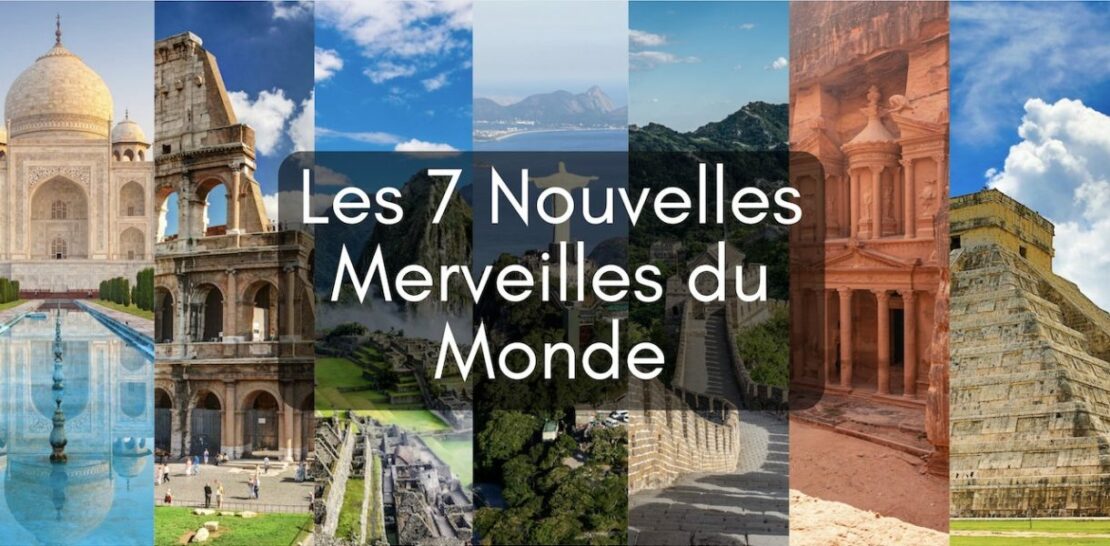Have you ever dreamt of traveling the world and exploring its endless marvels?
There’s no better way to start your journey than by visiting the 7 New Wonders of the World.
These architectural and natural masterpieces, chosen through a global poll by millions of people, offer a glimpse into the incredible history, culture, and beauty that our planet has to offer.
This comprehensive guide will take you on an awe-inspiring journey to these wonders, delving deep into their origins, significance, and the stories that make them truly unforgettable.
An Enchanting Stroll Through the Great Wall of China
A testament to human will and determination, the Great Wall of China is a colossal triumph of ancient engineering.
Stretching over a staggering 13,170 miles, the Great Wall was built over two millennia ago to protect the Chinese empire from invasions. Construction started during the 7th century BC, with various dynasties adding to and rebuilding the wall over time. The majority of the existing wall was constructed during the Ming Dynasty (1368-1644).
This awe-inspiring structure is not just about its sheer size, but also the breathtaking landscapes it passes through. The wall winds through mountains, deserts, and grasslands, offering spectacular views of China’s diverse terrain. The Badaling section is the most popular among tourists, while the Mutianyu and Jiankou sections offer more challenging and rewarding experiences for adventurers.
The Great Wall is not only a symbol of China’s rich history but also of the resilience and ingenuity of its people. It remains one of the most remarkable engineering achievements in human history and an enduring icon of human endeavor.
Unveiling the Mysteries of the Lost City: Petra, Jordan
The ancient city of Petra, nestled in the heart of the Jordanian desert, is a breathtaking example of human ingenuity and artistic achievement.
- The Nabataeans, a nomadic Arab tribe, established Petra as their capital in the 4th century BC. They were expert traders, controlling the lucrative spice trade routes that passed through the region.
- Petra is home to over 800 individual monuments, including tombs, temples, and elaborate rock-cut facades. The most famous of these is the iconic Treasury, a stunning example of Hellenistic architecture carved directly into the sandstone cliffs.
- In addition to its architectural wonders, Petra is also renowned for its advanced water management system. The Nabataeans constructed a complex network of dams, channels, and reservoirs to effectively capture and store the scarce desert rainfall.
- Petra’s eventual decline began in the 2nd century AD, with the rise of the Roman Empire and the gradual shift of trade routes. The city was ultimately abandoned after a series of earthquakes in the 6th and 7th centuries.
Today, Petra stands as an enduring testament to the creativity and resourcefulness of the Nabataean people and an enchanting window into a fascinating chapter of human history.
Discovering the Splendor and Tragedy of the Roman Colosseum
The Roman Colosseum, an enduring symbol of the power and grandeur of the Roman Empire, boasts a rich and tumultuous history.
- Construction: Commissioned by Emperor Vespasian in 70 AD, the Colosseum was completed in 80 AD under his successor, Emperor Titus. The massive amphitheater, constructed from concrete and sand, could hold up to 50,000 spectators.
- Gladiatorial Games: The Colosseum was the stage for brutal and bloody gladiatorial games, where men and animals fought to the death for the entertainment of the Roman populace. These games served as a symbol of Rome’s imperial might and a means of social control.
- Architectural Innovation: The Colosseum’s design, featuring a complex system of vaulted arches and tiered seating, was a groundbreaking feat of engineering. Its ingenious use of space and materials would inspire countless future architectural achievements.
- Legacy: Although partially ruined by natural disasters and stone theft, the Colosseum remains an iconic and enduring symbol of ancient Rome’s extraordinary powerand influence. It serves as a poignant reminder of the grandeur and tragedy that defined this remarkable civilization.
The Roman Colosseum continues to captivate millions of visitors each year, offering a fascinating glimpse into the brutal and opulent world of ancient Rome.
Immerse Yourself in the Spiritual Majesty of Machu Picchu, Peru
Perched high in the Andes Mountains of Peru, the ancient citadel of Machu Picchu is a stunning testament to the architectural prowess and spiritual significance of the Inca civilization.
The city, built in the 15th century under the rule of Inca emperor Pachacuti, was a vital center for religious, agricultural, and astronomical activities. Its masterful stone architecture, crafted with remarkable precision and without the use of mortar, has withstood the test of time and the region’s frequent earthquakes.
Machu Picchu’s most iconic structures include the Temple of the Sun, the Intihuatana (an astronomical observatory), and the meticulously terraced agricultural fields, which demonstrate the Inca’s advanced understanding of agriculture and irrigation.
The city, however, was abandoned within a century of its construction, likely due to the Spanish conquest and the spread of disease. It remained hidden from the outside world until its rediscovery in 1911 by American explorer Hiram Bingham.
Today, Machu Picchu is a UNESCO World Heritage site and a powerful symbol of the Inca civilization’s extraordinary achievements and spiritual connection to the natural world. Visiting this awe-inspiring city is a transformative experience, offering a profound appreciation for the ingenuity and resilience of the Inca people.
Delve into the Sacred Beauty of Chichen Itza, Mexico
Chichen Itza, an ancient Mayan city in Mexico’s Yucatan Peninsula, is a mesmerizing window into the complex and sophisticated world of the Mayan civilization.
At its zenith between the 9th and 12th centuries, Chichen Itza was a major religious, political, and economic center, home to a diverse and thriving population. The city’s architecture reflects this diversity, with a unique blend of Mayan and Toltec styles.
The most iconic structure of Chichen Itza is the Temple of Kukulkan, also known as El Castillo. This massive pyramid, dedicated to the feathered serpent deity Kukulkan, is a marvel of ancient astronomy. Its precise alignment allows for a stunning display of light and shadow during the spring and autumn equinoxes, when the sun casts a serpent-like shadow along the steps of the pyramid.
Other notable structures in Chichen Itza include the Great Ball Court, the largest and best-preserved ancient ball court in Mesoamerica, and the Temple of the Warriors, adorned with intricate carvings and imposing stone columns.
Chichen Itza remains a powerful symbol of the Mayan civilization’s profound understanding of astronomy, mathematics, and architecture, and a captivating portal to a world steeped in myth, ritual, and mystery.
Behold the Ethereal Elegance of the Taj Mahal, India
The Taj Mahal, a gleaming white marble mausoleum in Agra, India, is a sublime expression of love and a masterpiece of Mughal architecture.
Constructed between 1631 and 1648 by Emperor Shah Jahan in memory of his beloved wife Mumtaz Mahal, the Taj Mahal is an exquisite example of symmetry, balance, and harmony. Its iconic central dome, surrounded by four smaller domes and slender minarets, creates an ethereal silhouette against the sky.
The mausoleum’s interior is adorned with intricate carvings, precious stones, and masterful calligraphy, while the surrounding gardens, with their reflecting pools and meticulously manicured lawns, evoke a sense of tranquility and serenity.
As a symbol of eternal love and a testament to the artistic and architectural achievements of the Mughal Empire, the Taj Mahal continues to inspire and enamor visitors from around the world.
Embrace the Enduring Majesty of Christ the Redeemer, Brazil
Standing tall atop Corcovado Mountain in Rio de Janeiro, the statue of Christ the Redeemer is a powerful emblem of faith and a symbol of the warmth and welcome of the Brazilian people.
Designed by Brazilian engineer Heitor da Silva Costa and French sculptor Paul Landowski, thestatue was completed in 1931 after nearly a decade of construction. At 98 feet tall, with an arm span of 92 feet, Christ the Redeemer is the largest art deco statue in the world and an astonishing feat of engineering.
The statue itself is a striking representation of Jesus Christ, standing with arms outstretched in a gesture of compassion and embrace. The figure’s serene expression and gentle gaze convey a sense of divine love and protection, while its commanding position overlooking the city serves as a constant reminder of the power and presence of faith.
Visitors to Christ the Redeemer are treated to breathtaking panoramic views of Rio de Janeiro, including the iconic Sugarloaf Mountain, the vibrant cityscape, and the pristine beaches of Copacabana and Ipanema. The statue also holds a special place in the hearts of the Brazilian people, serving as a unifying symbol of their cultural identity and spiritual connection.
In conclusion, the 7 New Wonders of the World represent the pinnacle of human achievement and the boundless potential of our collective imagination. From the ancient ingenuity of the Great Wall of China to the enduring elegance of the Taj Mahal, these awe-inspiring marvels offer a glimpse into the extraordinary tapestry of human history and the indomitable spirit of our ancestors. As we continue to explore and celebrate these wonders, we are reminded of the power of human creativity and the enduring beauty of our shared cultural heritage.




